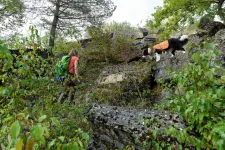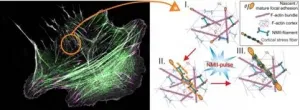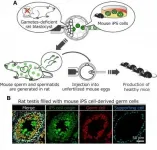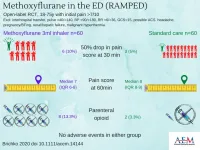(Press-News.org) The lists of Earth's endangered animals and plants are getting increasingly longer. But in order to stop this trend, we require more information. It is often difficult to find out exactly where the individual species can be found and how their populations are developing. According to a new overview study published in Methods in Ecology and Evolution by Dr Annegret Grimm-Seyfarth from the Helmholtz Centre for Environmental Research (UFZ) and her colleagues, specially trained detection dogs can be indispensable in such cases. With the help of these dogs, the species sought can usually be found faster and more effectively than with other methods.
How many otters are there still in Germany? What habitats do threatened crested newts use on land? And do urban hedgehogs have to deal with different problems than their rural conspecifics? Anyone wishing to effectively protect a species should be able to answer such questions. But this is by no means easy. Many animals remain in hiding - even their droppings can be difficult to find. Thus, it is often difficult to know exactly whether and at what rate their stocks are shrinking or where the remaining survivors are. "We urgently need to know more about these species", says Dr Annegret Grimm-Seyfarth of the UFZ. "But first we must find them".
Remote sensing with aerial and satellite images is useful for mapping open landscapes or detecting larger animals. But when it comes to densely overgrown areas and smaller, hidden species, experts often carry out the search themselves or work with cameras, hair traps, and similar tricks. Other techniques (e.g. analysing trace amounts of DNA) have also been attracting increasing interest worldwide. The use of specially trained detection dogs can also be particularly useful. After all, a dog's sense of smell is virtually predestined to find the smallest traces of the target species. While humans have about six million olfactory receptors, a herding dog has more than 200 million - and a beagle even 300 million. This means that dogs can perceive an extremely wide range of odours, often in the tiniest concentrations. For example, they can easily find animal droppings in a forest or plants, mushrooms, and animals underground.
At the UFZ, the detection dogs have already proven their abilities in several research projects. "In order to be able to better assess their potential, we wanted to know how detection dogs have previously been used around the world", says Grimm-Seyfarth. Together with UFZ employee Wiebke Harms and Dr Anne Berger from the Leibniz Institute for Zoo and Wildlife Research (IZW) in Berlin, she has evaluated 1220 publications documenting the use of such search dogs in more than 60 countries. "We were particularly interested in which breeds of dogs were used, which species they were supposed to track down, and how well they performed", explains the researcher.
The longest experience with the detection dogs is in New Zealand, where dogs have been tracking threatened birds since around 1890. Since then, the idea has been implemented in many other regions, especially in North America and Europe. The studies analysed focused mainly on finding animals as well as their habitats and tracks. Dogs have been used to find more than 400 different animal species - most commonly mammals from the cat, dog, bear, and marten families. They have also been used to find birds and insects as well as 42 different plant species, 26 fungal species, and 6 bacterial species. These are not always endangered species. The dogs sometimes also sniff out pests such as bark beetles or invasive plants such as knotgrass and ragweed.
"In principle, you can train all dog breeds for such tasks", says Grimm-Seyfarth. "But some of them may require more work than others". Pinschers and Schnauzers, for example, are now more likely to be bred as companion dogs and are therefore less motivated to track down species. And terriers tend to immediately snatch their targets - which is, of course, not desirable.
Pointers and setters, on the other hand, have been specially bred to find and point out game - but not to hunt it. This is why these breeds are often used in research and conservation projects in North America, Great Britain, and Scandinavia in order to detect ground-breeding birds such as ptarmigans and wood grouse. Retrievers and herding dogs also have qualities that make them good at tracking species. They are eager to learn, easy to motivate, enjoy working with people, and generally do not have a strong hunting instinct. That is why Labrador Retrievers, Border Collies, and German Shepherds are among the most popular detection dogs worldwide.
Grimm-Seyfarth's Border Collie Zammy, for example, learned as a puppy how to track down the droppings of otters. This is a valuable contribution to research because the droppings can be genetically analysed to find out which individual it comes from, how it is related to other conspecifics, and what it has eaten. However, even for experienced experts, these revealing traces are not so easy to find. Especially small and dark coloured droppings are easy to overlook. Dogs, on the other hand, sniff even the most unremarkable droppings without distinction. In an earlier UFZ study, they found four times as many droppings as human investigators alone. And the fact that Zammy is now also looking for crested newts makes his efforts even more rewarding.
According to the overview study, many other teams around the world have had similarly good experiences. In almost 90% of cases, the dogs worked much more effectively than other detection methods. Compared with camera traps, for example, they detected between 3.7 and 4.7 fold more black bears, pied martens, and bobcats. They are also often reach their destination particularly quickly. "They can find a single plant on a football field in a very short time", says Grimm-Seyfarth. They are even able to discover underground parts of plants.
However, there are also cases where the use of detection dogs is not the method of choice. Rhinos, for example, leave their large piles of excrement clearly visible on paths so that humans can easily find them on their own. And animal species that know feral dogs as enemies are more likely to find (and fight) the detection dogs than to be found.
"However, in most cases where the dogs did not perform so well, poor training is to blame", says Grimm-Seyfarth. She believes that good training of the animal is the most important recipe for success for detection dogs. "If you select the right dog, know enough about the target species, and design the study accordingly, this can be an excellent detection method". She and her colleagues are already planning further applications for the useful detection dogs. A new project that involves tracking down invasive plant species will soon be launched.
INFORMATION:
TPU researchers jointly with their colleagues from foreign universities have developed a method that allows for a laser-driven integration of metals into polymers to form electrically conductive composites. The research findings are presented in Ultra-Robust Flexible Electronics by Laser-Driven Polymer-Nanomaterials Integration article Ultra-Robust Flexible Electronics by Laser-Driven Polymer-Nanomaterials Integration, published in Advanced Functional Materials academic journal (Q1, IF 16,836).
"Currently developing breakthrough technologies such as the Internet of Things, flexible electronics, brain-computer interfaces will have a great impact on ...
The key are the ultra-fast flashes of light, with which the team led by Dr. Friedrich Roth works at FLASH in Hamburg, the world's first free-electron laser in the X-ray region. "We took advantage of the special properties of this X-ray source and expanded them with time-resolved X-ray photoemission spectroscopy (TR-XPS). This method is based on the external photoelectric effect, for the explanation of which Albert Einstein received the Nobel Prize in Physics in 1921.
"For the first time, we were able to directly analyze the specific charge separation and subsequent processes when light hits a model system such as an organic solar cell. ...
Research groups at the University of Helsinki uncovered how motor protein myosin, which is responsible for contraction of skeletal muscles, functions also in non-muscle cells to build contractile structures at the inner face of the cell membrane. This is the first time when such 'mini-muscles', also known as stress fibers, have been seen to emerge spontaneously through myosin-driven reorganization of the pre-existing actin filament network in cells. Defects in the assembly of these 'mini-muscles' in cells lead to multiple disorders in humans, and in the most severe cases to cancer progression.
A new study published in eLife, drills into the core mechanisms of stress fiber assembly, and reveals how stress fibers can be built directly ...
Okazaki, Japan - Making gametes such as sperm and eggs from pluripotent stem cells, primitive cells that can make all the tissues, greatly contributes to efficient reproduction of livestock animals and future assisted reproductive medicine. Researchers pave the way to achieve this goal using a body of xenogenic animals.
The researchers previously developed a method to grow stem cells into an entire organ in the body, so-called blastocyst complementation. The blastocyst is a structure of early embryos. If stem cells are transplanted into the blastocyst obtained from animals that cannot make a certain organ, ...
Advances in hydraulic fracturing technology have enabled discovery of large reserves of natural gas which primarily contains methane, which is mainly burned directly and causing global warming potentially. Upgrading methane to greener energy such as methanol through aerobic oxidation is an ideal way to solve the problem and remain 100% atom economy.
Yet the difficulties lie in activating methane and preventing methanol from over-oxidation. Methane takes a stable non-polar tetrahedral structure with high dissociation energy of C-H bond, which requires high energy to be activated. ...
Des Plaines, IL - Initial management with inhaled methoxyflurane in the emergency department did not achieve the prespecified substantial reduction in pain, but was associated with clinically significant lower pain scores compared to standard therapy. That is the conclusion of a study titled Rapid Administration of Methoxyflurane to Patients in the Emergency Department (RAMPED) Study: A Randomized Controlled Trial of Methoxyflurane Versus Standard Care that was published recently in the February 2021 issue of Academic Emergency Medicine (AEM), a journal of the Society for Academic Emergency Medicine (SAEM).
According to findings of the controlled randomized trial, secondary outcomes included the pain ...
Northwestern Engineering researchers have developed a theoretical model to design soft materials that demonstrate autonomous oscillating properties that mimic biological functions. The work could advance the design of responsive materials used to deliver therapeutics as well as for robot-like soft materials that operate autonomously.
The design and synthesis of materials with biological functions require a delicate balance between structural form and physiological function. During embryonic development, for instance, flat sheets of embryonic cells morph through a series of folds into intricate three-dimensional structures such as branches, tubes, and furrows. These, in turn, become dynamic, three-dimensional building blocks for organs performing vital functions ...
Washington, March 2, 2021--A first-of-its-kind analysis of parents' reviews of U.S. public K-12 schools, posted primarily from 2009 to 2019 on the popular school information site GreatSchools.org, found that most reviews were written by parents at schools in affluent neighborhoods and provided information that correlated strongly with test scores, a measure that closely tracks race and family income. Language associated with school effectiveness, which measures how much students improve in their test scores over time and is less correlated with demographics, was ...
Eighty percent of Americans over 50 say their primary care doctor hasn't asked about their hearing in the past two years, and nearly as many - 77% -- haven't had their hearing checked by a professional in that same time, according to a new national poll report.
That's despite a growing body of evidence about the importance of hearing to other aspects of life, from dementia and risk of falls to the ability to stay connected to friends and family.
Men were more likely than women to say they'd had a recent hearing screening or test, and so were people ages 65 to 80 compared with those in ...
COLUMBUS, Ohio - Black players in the NBA have 30% greater odds of leaving the league in any given season than white players who have equivalent performance on the court, a new study finds.
The results were driven mostly by bench players, who are the majority of those in the league, but who average less than 20 minutes of action per game.
These findings suggest that even in the NBA - a league in which Black players make up 70-75% of those on the court - African Americans face discrimination, said Davon Norris, lead author of the study and a doctoral student in sociology at The Ohio State University.
"If there is going to be anywhere in America where you would expect there wouldn't be racial ...







